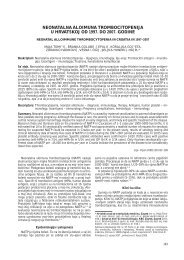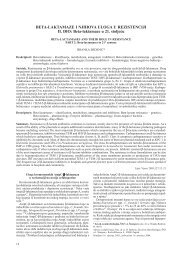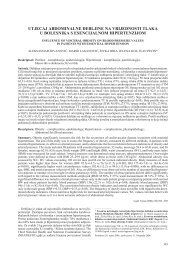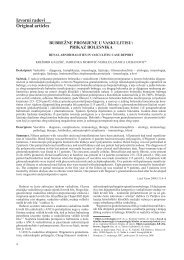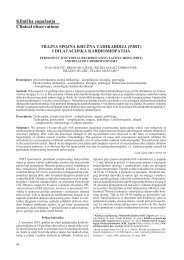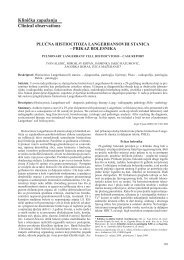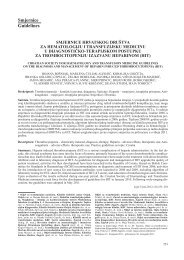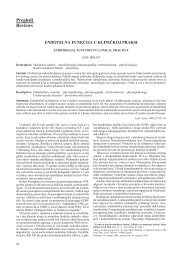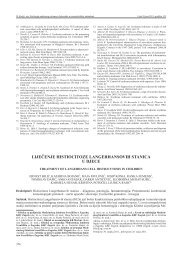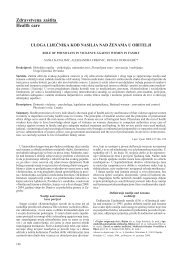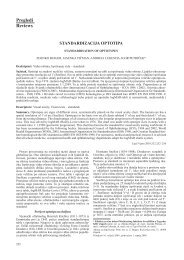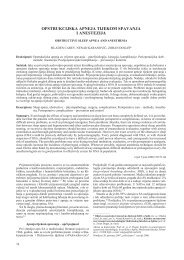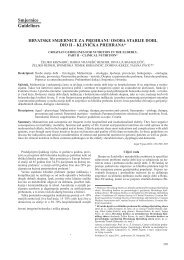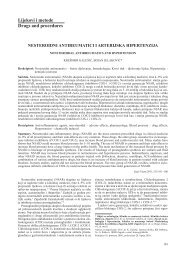bolesnik sa inzulinomom koji se prezentirao kao paroksizmalni nocni
bolesnik sa inzulinomom koji se prezentirao kao paroksizmalni nocni
bolesnik sa inzulinomom koji se prezentirao kao paroksizmalni nocni
Create successful ePaper yourself
Turn your PDF publications into a flip-book with our unique Google optimized e-Paper software.
INSULINOMA PRESENTING ITSELF<br />
AS A NIGHT PAROXYSMAL DISORDER<br />
WITH SPONTANEOUS RECOVERY<br />
BOLESNIK SA INZULINOMOM KOJI SE PREZENTIRAO<br />
KAO PAROKSIZMALNI NO]NI POREME]AJ SA SPONTANIM OPORAVKOM<br />
LEJA DOLENC GRO[ELJ, DU[AN BUTINAR*<br />
Descriptors: insulinoma; polysomnography; night paroxysmal movement disorder<br />
Summary. A 64-year-old woman with night paroxysmal episodes is described. Her symptoms began 9 months ago with<br />
attacks of bizarre movement, which were always pre<strong>se</strong>nt in the <strong>se</strong>cond part of the night. She had no attacks during the<br />
daytime. Her husband reported confusion and disorientation followed by long periods of unresponsiveness. The patient<br />
underwent a night polysomnography recording. Around 4 o’clock in the morning bizarre movements with stereotypic<br />
behaviour appeared. She was rolling her head from side to side, moaning, and stretching her limbs. The<strong>se</strong> periods first lasted<br />
for minutes, and were constantly repeated during the night. EEG findings suggested metabolic encephalopathy. At that time<br />
finger prick test revealed a profound hypoglycaemia (1.2 mmol/l), high insulin (200 pmol/l), and C-peptide (6.63 nmol/l).<br />
Ultrasonography and MRI confirmed the insulinoma in the head of the pancreas. To our knowledge our ca<strong>se</strong> is the first<br />
patient with insulinoma attacks only during sleep time.<br />
Deskriptori: inzulinom, polisomnografija, poreme}aj <strong>paroksizmalni</strong>h pokreta no}u<br />
Sa`etak. U radu je opi<strong>sa</strong>na 64-godi{nja `ena s epizodama paroksizama tijekom no}i. Simptomi su zapo~eli prije 9 mje<strong>se</strong>ci s<br />
atakama bizarnih pokreta, koje su <strong>se</strong> uvijek javljale u drugom dijelu no}i. tijekom dana nije imala atake. Njezin suprug<br />
navodi da je bila konfuzna i dezorijentirana, nakon ~ega je slijedilo du`e razdoblje nereagiranja. Pacijentici je u~injena<br />
no}na polisomnografija. Oko 4 <strong>sa</strong>ta ujutro pojavili su <strong>se</strong> bizarni pokreti uz stereotipno pona{anje. Vrtjela je glavom s jedne<br />
na drugu stranu, stenjala i istezala udove. Ovo je isprva trajalo nekoliko minuta, a tijekom no}i stalno <strong>se</strong> ponavljalo. EEG<br />
nalaz je upu}ivao na metaboli~ku encefalopatiju. U to je vrijeme u krvi iz prsta na|ena izrazita hipoglikemija (1,2 mmol/l),<br />
visok inzulin (200 mmol/l) i C-peptid (6,63 µmol/l). Ultrasonografija i MEI potvrdile su inzulinom u glavi pankrea<strong>sa</strong>. Prema<br />
na{im <strong>sa</strong>znanjima ovo je prvi slu~aj ataka inzulinom tijekom spavanja.<br />
Lije~ Vjesn 2008;130:104–105<br />
Ca<strong>se</strong> report<br />
A 64-year-old woman was referred for polysomnography<br />
to get a diagnosis of night paroxysmal episodes. She had a<br />
hypernefroma of the right kidney with nefrectomy performed<br />
a year ago and was treated for hyperlipidemia and hypertension.<br />
Her symptoms began 9 months ago with attacks<br />
of bizarre movement, which were always pre<strong>se</strong>nt in the <strong>se</strong>cond<br />
part of the night. She had no attacks during the daytime.<br />
Her husband reported confusion and disorientation followed<br />
by long periods of unresponsiveness (1–2 hours). Twice<br />
during the attack she fell from bed and sustained light injuries.<br />
Neurological, general examination and daytime EEG<br />
were normal. MRI brain scan demonstrated a few small<br />
ischemic lesions in periventricular regions on both sides.<br />
During the last 9 months a psychiatrist and a neurologist diagno<strong>se</strong>d<br />
her with parasomnia late on<strong>se</strong>t epilepsy Diazepam<br />
in the evenings was prescribed by the psychiatrist.<br />
The patient underwent a polysomnography recording. In<br />
the first part of the night her sleep was normal. Some obstructive<br />
apnoeas (AHI = 8) were found. Around 4 o’clock<br />
in the morning bizarre movements with stereotypic behaviour<br />
appeared. She was rolling her head from side to side,<br />
moaning, and stretching her limbs. Tonic or clonic components<br />
were ab<strong>se</strong>nt. No dystonic postures were ob<strong>se</strong>rved.<br />
The<strong>se</strong> periods first lasted for minutes, and were constantly<br />
repeated. During the<strong>se</strong> attacks she was intermittently confu<strong>se</strong>d<br />
and disoriented. After 6 o’clock she became cold,<br />
sweaty and confu<strong>se</strong>d. EEG showed bilateral slow theta and<br />
delta activity, accentuated in the centro-temporal regions bilaterally.<br />
There was no epileptiform activity. EEG findings<br />
suggested metabolic encephalopathy. At that time finger<br />
prick test revealed a profound hypoglycaemia (1.2 mmol/l).<br />
High insulin (200 pmol/l) and C-peptide (6.63 nmol/l) <strong>se</strong>cretion<br />
were found. After administration of sweet tea and 5%<br />
gluco<strong>se</strong> infusion she become oriented and well. Polysomnography<br />
showed wake state with alpha activity. The patient<br />
was transferred to the Endocrine Unit. Ultrasonography of<br />
abdomen was negative, while on the endoscopic ultrasonography<br />
hypoechogenic lesion- insulinoma- (2.9×1.5 cm)<br />
was found in the head of the pancreas. MRI (T2 FAT SAT)<br />
confirmed hyper intensive round formation (2.2×1.8 cm) in<br />
the head of the pancreas. While waiting for surgery the patient<br />
was given a late dinner and a small snack during the<br />
night and was completely free of night attacks. Two months<br />
later surgery of the pancreas was performed, but insulinoma<br />
was not found. Currently she is under endocrine and neurological<br />
ob<strong>se</strong>rvation as an outpatient and is practicing the<br />
<strong>sa</strong>me eating regime. Measurements of gluco<strong>se</strong> are in normal<br />
range. She has been completely free of above mentioned<br />
nighttime events for a year.<br />
———————<br />
* Institute of Clinical Neurophysiology, University Medical Centre,<br />
Ljubljana, Slovenia (dr. sc. Leja Dolenc Gro{elj, dr. med.; dr. sc. Du{an<br />
Butinar, dr. med.)<br />
Adre<strong>sa</strong> za dopisivanje: Dr. L. Dolenc Gro{elj, Institute of Clinical Neurophysiology,<br />
University Medical Centre, Ljubljana, Slovenia, e-mail: leja.dolencºkclj.si<br />
Primljeno 7. velja~e 2008., prihva}eno 22. travnja 2008.<br />
104
Lije~ Vjesn 2008; godi{te 130<br />
L. Dolenc Gro{elj, D. Butinar. Insulinoma pre<strong>se</strong>nting it<strong>se</strong>lf as a night paroxysmal disorder with spontaneous recovery<br />
Conclusion<br />
Insulinoma is pancreatic endocrine tumour characterized<br />
by hyperinsulinemic hypoglycaemia, which can mimic various<br />
neurological pictures (acute disorder of cognition, consciousness,<br />
epilepsy, transient ischaemia, psychosis or chronic<br />
disorders of dementia and neuropathy. 1–4 To our knowledge<br />
our ca<strong>se</strong> is the first patient with insulinoma attacks only<br />
during sleep time. Therefore we suggest, that when bizarre<br />
paroxysmal movement is pre<strong>se</strong>nt only during nighttime, metabolic<br />
disorders are considered in the differential diagnosis.<br />
REFERENCES<br />
1. Graves TD, Gandhi S, Smith SJM, Sisodiya SM, Conway GS. Misdiagnosis<br />
of <strong>se</strong>izures: insulinoma pre<strong>se</strong>nting as adult-on<strong>se</strong>t <strong>se</strong>izure disorder.<br />
J Neurol Neurosurg Psychiatry 2004;75:1091–1092.<br />
2. Shaw C, Haas L, Miller D, Delahunt J. A ca<strong>se</strong> report of paroxysmal<br />
dystonic choreathetosis due to hypoglycemia induced by an insulinoma.<br />
J Neurol Neurosurg Psychiatry 1996;61(2):194–5.<br />
3. Striano P, Striano S. Insulinoma pre<strong>se</strong>nting as refractory late-on<strong>se</strong>t epilepsy.<br />
Epilepsia 2006;47(2):452.<br />
4. Dion MH. Cos<strong>se</strong>tte P, St-Hilaire JM i sur. Insulinoma misdiagno<strong>se</strong>d as<br />
intractable epilepsy. Neurology 2004;62(8):1443–5.<br />
Vijesti<br />
News<br />
<br />
European Society of Pathology<br />
Academy of Medical Sciences of Croatia<br />
Institute for Clinical Medical Re<strong>se</strong>arch of Sestre milosrdnice University Hospital Zagreb<br />
Veterinary Faculty Zagreb<br />
19 th Ljudevit Jurak International Symposium on Comparative Pathology<br />
SECOND ANNOUNCEMENT AND CALL FOR PAPERS<br />
June 6—7, 2008<br />
Multimedia center, Sestre milosrdnice University Hospital,<br />
Vinogradska cesta 29, Zagreb, Croatia<br />
(http://www.kbsm.hr/Jurak/symposium.htm)<br />
The main symposium topics are Pediatric Pathology and Advances in Pathomorphology Techniques.<br />
PRVI HRVATSKI KONGRES DILEMA U NEUROLOGIJI<br />
s me|unarodnim sudjelovanjem<br />
8.–12. listopada 2008.<br />
Opatija, Grand Hotel Adriatic, Hrvatska<br />
Organizatori kongre<strong>sa</strong>:<br />
Klinika za neurologiju Medicinskog fakulteta i Klini~kog bolni~kog centra Zagreb<br />
Hrvatsko dru{tvo za EEG i klini~ku neurofiziologiju, HLZ<br />
Hrvatsko neurobiolo{ko dru{tvo, HLZ<br />
Hrvatsko dru{tvo za neuromuskularne bolesti i EMNG, HLZ<br />
Sekcija za intenzivnu neurologiju Hrvatskog neurolo{kog dru{tva, HLZ<br />
Referentni centar za epilepsije Ministarstva zdravstva i socijalne skrbi RH<br />
Referentni centar za neuromuskularne bolesti Ministarstva zdravstva i socijalne skrbi RH<br />
Referentni centar za demijelinizacijske bolesti sredi{njeg `iv~anog sustava Ministarstva zdravstva<br />
i socijalne skrbi RH<br />
Kontakt osoba: g|a Alek<strong>sa</strong>ndra Novo<strong>se</strong>l, Klinika za neurologiju, Klini~ki bolni~ki centar Zagreb<br />
Ki{pati}eva 12, 10 000 Zagreb; tel. +385 1 2388 310, fax: +385 1 2421 846<br />
e-mail: dileme2008ºnet.hr<br />
Registracija i prijava <strong>sa</strong>`etaka: www.dileme2008.com<br />
Kotizacija: Do 1. srpnja 2008. 1500 Kn<br />
Nakon 1. srpnja 2008. 2000 Kn<br />
Za specijalizante 1000 Kn<br />
Za osobe u pratnji 1000 kn<br />
Za jedan dan kongre<strong>sa</strong> 1000 Kn<br />
Rok za slanje <strong>sa</strong>`etaka: 1. srpnja 2008.<br />
105



